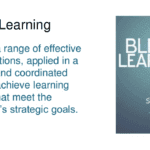10 Tips to Extend Learning

Tips to Extend Learning and Set Up Learners for Success: Tools Every L&D Pro Can Use Right Now, Pt 3
This is third in a three part series. If you missed part one on empowering knowledge sharing, read it here. For part two on turning challenging dynamics to transformative learning, read it here.
Humans are wired to learn and we do so every day, both in and outside of learning programs. When you create learning events for others, it’s important to consider how the experience you’re creating fits into their already ongoing journey of learning. At the end of the event, how are you going to set up your learners for success and extend their learning into their lives and workplace?
End Strategically to Set up Learners for Success
L&D pros don’t always realize that how you close out your learning program is almost more important than how you start it. It is the last thing that people will remember, and you have an opportunity to send them off feeling motivated and inspired, no matter what the topic is.
The end is also where things can get chaotic because you might be feeling rushed if you got behind in your agenda. And there are also tactical issues to take care of like evaluations. Take the time to design the ending of your event so that you create the appropriate emotional closure for your group. And also to extend their learning beyond the day you deliver it.
Here are some things to consider when wrapping up your learning experience. There will probably be an ideal order for the topic and group you are leading, so move them around accordingly.
- Be sure you review the key points
I find it helpful to put a second copy of the agenda or learning objectives slide at the end, and use it as a way to do a quick review of the material we covered. This buttons up the learning and helps participants reflect back on the learning journey you created.
- Give people time to synthesize their own key takeaways
After I review the agenda, I give people 5 minutes to make a list of their key insights and takeaways. This helps them personalize the material to their experience and sets an expectation that they start using the material right away.
- Have your participants create an action plan
If you’re asking participants to do any post-event work or extended learning, give people a handout where they can write down their action plan. Depending on the content, I sometimes frame this as a 30-60-90-day plan.
- Have learners schedule some initial items on their calendar
This can be a powerful way to make sure they keep the momentum going after they leave the event. You could have them take out their smartphones right then and put some time on their calendar to work on an action item, review the workshop materials, or schedule a virtual coffee with another participant. But be careful. It can also take people away from being present if they start reading their email or thinking about how busy they are. So, make a judgment call about what is best for your group.
- Take care of important logistics
This can include a range of things like completing evaluations, setting up post-event work, and exchanging contact information.
- Finally, leave the group on a high note of inspiration
I will save an activity, fun video, or great quote to share at the end, to bring the group back from the tactical stuff to the event’s positive tone. And if it feels right, I will ask people to close by sharing something they are feeling or that they learned. If you have time, it’s nice to go around the group and hear from everyone. (Ask them to keep it brief; just a few words.) If you don’t have time, take at least one minute to have them share on the chat box or in pairs or trios. That way, every person gets to say something.
Closing your program is an important part of the facilitator’s role. You want to set your participants up for success as they leave the special environment you created and integrate what they learned back into their regular lives. By making it positive and memorable, you will send them off with a last touch of your valuable guidance.
Keep the Momentum Going with Extended Learning
If you have done a good job, your participants are excited about what they learned in your program and are eager to do more. Take advantage of that energy by setting them up with clear next steps for them to extend their learning. This keeps momentum going, but it’s also great practice for learning-design based on what we know about how the brain works. Extended learning helps move the content into long-term memory and adds more repetitions to the neural pathways, building the right habits.
There are lots of ways to extend learning. The right choice will depend on what kind of workshop you led and what change you are trying to create in the participants. Here are some good examples.
Provide a list of relevant or related materials
This can include articles, books, chapters, videos, websites, online courses, etc. Ask people to pick something from the list that interests them and commit to doing it in the next two weeks. It is fairly easy to make the list. I often share the source material I used when creating the workshop in case people want to do a deeper dive into something specific we covered. If you are trying to elicit more critical or creative thinking, include materials that diverge from or openly challenge what you taught. And even ask for participants to contribute to the list if they find articles, videos, and other resources that inspired them. In fact, if you have some for this article, share them in the comment section below.
Set up opportunities to practice
Practice is the only way we get better at things. But it can be challenging for learners to find the time to practice or even know how to set up the right kind. Help them by giving them specific activities to do when they return to their regular environments. Whether it’s a set of worksheets to complete, online assessments to submit, or a certain number of repetitions of a behavior to finish, helping your learners get that valuable practice that will set them up for success.
Empower shared learning in pairs or groups
When people learn together, it can amplify their progress because they build on each other’s insights and experiences. In addition, the content gets anchored to the relationship, which reinforces it when they see each other later. You can continue this outside of the workshop by requesting or requiring people to meet in pairs or groups for discussions or practice work. This can include online interactions or face-to-face meetings. Shared learning also creates accountability since learners are more likely to keep a commitment to their partner even when their schedule gets busy.
Hold your learners accountable to finish their work
The more your learners are supported in completing the work and the practice, the more likely you are to see the real behavior change you are seeking. Many learning platforms have features that enable different kinds of activities and engagements. Set these up with clear deadlines and scheduling reminders.
I love the results I get with extended learning. It gives the eager and motivated learners something to work with, and it allows me to see who the eager and motivated learners are. In addition, it helps me think more clearly about which level of depth is enough for the goals of the workshop while allowing for more to unfold outside the formal bounds of the event. Give it a try and see how it works for you. I think you’ll be pleased with the results.
This post is adapted from Wired to Grow: Harness the Power of Brain Science to Learn and Master Any Skill. Get a free chapter here.
Related Blogs
JOIN OUR COMMUNITY
Be the first to know of Dr. Britt Andreatta's latest news and research.




